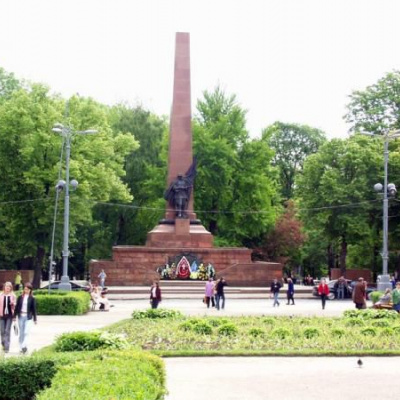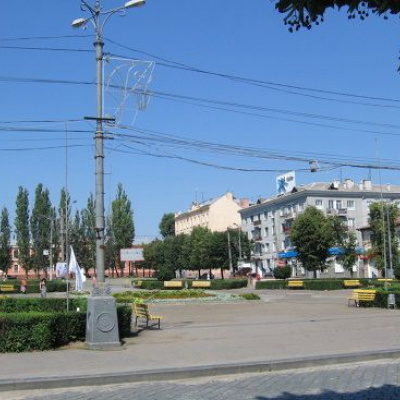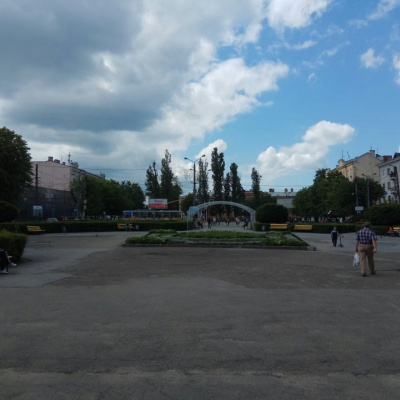Soborna Square, Chernivtsi
Soborna (formerly Austrian) Square is the largest square in the city. Once upon a time, it was a vacant lot where fairs were organized, accompanied by music, jostling and entertainment. It was organized every summer for 14 days. Traveling artists and folk musicians performed on temporary wooden platforms in the open air.
In the center of the square, a monument symbolizing Austria was erected to mark the 100th anniversary of the conquest of Bukovyna by Austria. Its height was over 8 meters, the main figure was made of white Caravan marble, and the reliefs were made of gold. It was then that this square became Austria Square. This official name, as well as the monument, existed until the Romanian occupation of 1918. In Soviet times, the Victory Obelisk (1946) was erected on the same square. The blue four-story building next to the obelisk is the building of the former Bukovinian Landtag (provincial government). The building's design was prepared by Josef Hlavka together with Gaubitz. The building itself was constructed in strict classical forms between 1869 and 1873. The columns of the central risalit, tympanums, and sandrakes above the windows of the second floor make the building solemn and majestic. Today it houses the fourteenth building of the Chernivtsi National University.
A quiet street behind the university building, named after Omelian Popovych, leads to the pseudo-Gothic Jesuit Church of the Heart of Jesus, built in 1891-1894 on Ferdinand Square at the request of missionaries from the Society of Jesus. The church was designed by the director of the Chernivtsi School of Crafts, Professor J. Leisner. The interior space of the church, which can accommodate 800 people, is crowned with nerve-racking vaults supported by pillars. In the past, the interior of the building was decorated with icons by prominent masters of the late nineteenth and early twentieth centuries, numerous stucco figures, cast bronze candles, and pompous turns that "sifted" the light to create a solemn and calm mood. It immediately became a landmark of the city. Its high spire can be seen from all the outskirts of Chernivtsi, enchanting the viewer with its majesty. The slender neo-Gothic forms, elegant interior, colorful stained glass windows, and majestic organ gave the church a peculiar Western European flavor. Currently, the church is used by the State Archives of Chernivtsi Oblast.
The Austrian square, now Soborna Square, is the highest point in the center of Chernivtsi (225 meters). It is home to one of the oldest markets in the city, where firewood was sold. Because of this, the square was once called Holzplatz ("Wooden" or "Wood"). Later, when a criminal court and a prison were located there, the square was called Kryminalplatz, and only in 1875 it was named Austria Platz in honor of the hundredth anniversary of Austrian rule in Bukovyna. The sculpture was created by the sculptor Karl Pekari from Carthusian marble and depicted an allegory of Austria. The sculpture was somewhat reminiscent of Empress Maria Theresa, during whose reign Bukovyna became part of Austria. The monument was destroyed after the First World War, but the ruined sculpture was found in 2003. In the background, you can see the building of the Land Criminal Court and the prison. It was built in 1819, making it the oldest administrative building that still fulfills its original function. The postcard also shows small private houses from the first generation of buildings on the square. Before the First World War, they were replaced by taller apartment buildings.
It is here that the Christmas tree is set up and the New Year and Christmas fair is held. Interestingly, there used to be an outskirts of the city called Drovianyi Maidan, where a prison was built in 1819. By the way, it is still there today. Since then, the square has been called Kryminalna Square. In the days of Austria-Hungary, it was called Austria Square, and in the days of the Romanians, it was called Piazza Girka Voda. The square is adjacent to the Cathedral of the Holy Spirit. Therefore, when in the nineteenth century this site was given for the construction of a government building, a number of conditions were set forth, one of which was that the square should never be built on. In 1873, a public garden was laid out here, and the ban on construction is still in place.
Walking further from the Cathedral Square, we will go down Ivan Franko Street and come to the "House with Lions"...
Chernivtsi is the capital of Bukovyna. It is one of the most beautiful and pleasant Ukrainian cities. Here is one of the most beautifulrailway stations in the country, theChurch of St. Paraskeva of Serbia, the Church of the Exaltation of the Cross, the house-ship, the City Hall (every day at 12:00 a trumpeter plays the melody of "Marichka" from the tower), the Art Museum, then Kobylianska Street, the German Folk House, the Armenian and Assumption Church (the oldest stone Ukrainian Greek Catholic Church in Chernivtsi), the Theater Square and the Kobylianska Theater. Kobylianska Theater Square, Jewish People's House, Chernivtsi University (included in the UNESCO World Heritage List), Turkish Square (Chernivtsi has been a part of Turkey, Modova, Romania, Austria-Hungary, the USSR, Rus, and Ukraine), and a large rover,cozy streets and cobblestones, the so-called Drunken Church, Nazariy Yaremchuk's house, then another house-ship, two houses with the same number (Olha Kobylianska lived here), the house where Volodymyr Ivasyuk lived, the pink church - the Cathedral of the Holy Spirit.
Chernivtsi sights
- St. Nicholas wooden church (from 1607, restored in 1954);
- Stone Church of St. George on the Bitterroot (1767 in the Baroque style);
- the wooden Trinity Church in Muggles (one thousand seven hundred and seventy-four), moved in 1874 to Kłokuchka;
- wooden Assumption Church on Kaleczanka (1783);
- City Hall with a two-story, 45-meter-high Empire-style tower (1843-1847, architect A. Mykulych), now the City Council;
- Ukrainian Greek Catholic Church (1825-1830 in the Baroque style);
- Byzantine-style cathedral (1844-1864, architect Roll);
- Church of St. Paraskeva in the pseudo-Romanesque style, completed in 1662 (architect A. Pavlovsky);
- residence of Bukovyna metropolitans - since 1956 one of the buildings of Chernivtsi University);
- Armenian Gregorian Church (1869-1875, architect J. Hlavka);
- Chernivtsi University building (1874-1875);
- Jesuit church in the Neo-Gothic style (1893-1894);
- Railway station (1898-1903) in the Art Nouveau style;
- the City Theater (1904-1905, architects F. Fellner and G. Helmer) in the Viennese Baroque style with Art Nouveau elements (now the O. Kobylianska Music and Drama Theater), etc.






